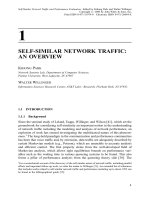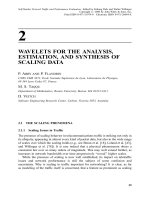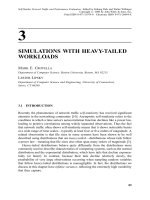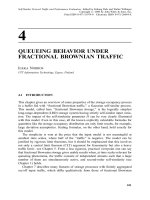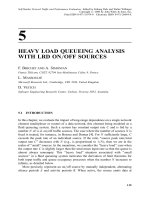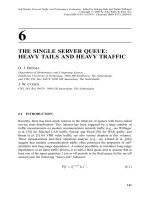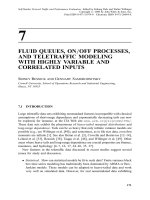Tài liệu Mạng lưới giao thông và đánh giá hiệu suất P4 doc
Bạn đang xem bản rút gọn của tài liệu. Xem và tải ngay bản đầy đủ của tài liệu tại đây (108.96 KB, 14 trang )
4
QUEUEING BEHAVIOR UNDER
FRACTIONAL BROWNIAN TRAFFIC
I
LKKA
N
ORROS
VTT Information Technology, Espoo, Finland
4.1 INTRODUCTION
This chapter gives an overview of some properties of the storage occupancy process
in a buffer fed with ``fractional Brownian traf®c,'' a Gaussian self-similar process.
This model, called here ``fractional Brownian storage,'' is the logically simplest
long-range-dependent (LRD) storage system having strictly self-similar input varia-
tion. The impact of the self-similarity parameter H can be very clearly illustrated
with this model. Even in this case, all the known explicitly calculable formulas for
quantities like the storage occupancy distribution are only limit results, for example,
large deviation asymptotics. Scaling formulas, on the other hand, hold exactly for
this model.
The simplicity is won at the price that the input model is not meaningful at
smallest time scales, where half of the ``traf®c'' is negative. The model can be
justi®ed by rigorous limit theorems, but it should be emphasized that this involves
not only a central limit theorem (CLT) argument for Gaussianity but also a heavy
traf®c limitÐsee Chapter 5. From a less rigorous, practical viewpoint one can say
that fractional Brownian storage gives usable results when, at time scales relevant for
queueing phenomena, the traf®c consists of independent streams such that a large
number of them are simultaneously active, and second-order self-similarity (see
Chapter 1) holds.
Chapter 7 describes many features of storage processes with ®nitely aggregated
on=off input traf®c, which differ qualitatively from those of fractional Brownian
Self-Similar Network Traf®c and Performance Evaluation, Edited by Kihong Park and Walter Willinger
ISBN 0-471-31974-0 Copyright # 2000 by John Wiley & Sons, Inc.
101
Self-Similar Network Traf®c and Performance Evaluation, Edited by Kihong Park and Walter Willinger
Copyright # 2000 by John Wiley & Sons, Inc.
Print ISBN 0-471-31974-0 Electronic ISBN 0-471-20644-X
storage. For example, the correlation function of the input process remains
unchanged if one changes the distributions of on and off periods to each other,
whereas the queueing process usually becomes entirely different. Thus second-order
self-similarity alone tells nothing about queueing behavior, if the traf®c variation
cannot be considered Gaussian. Another important difference can be seen in how a
queue builds up. Assume that the individual sources are relatively powerful so that a
queue starts to build up when a small number, say, k of them are simultaneously
active. Then a small increase in link speed can result in a considerable performance
improvement, if it happens to increase the small integer k by one. A related
observation about a possibly big effect of a small increase in buffer size is discussed
in Chapter 10 in GI=GI=1 context. In fractional Brownian traf®c, in contrast,
individual source streams are thought of as being in®nitely thin compared with the
link speed, and phenomena caused by the granularity of traf®c are not re¯ected in the
model.
On the other hand, if the Gaussian property is suf®ciently well satis®ed, but
second-order self-similarity holds only asymptotically, then some of the techniques
presented in this chapter are still usable in a modi®ed form. See Addie et al. [1].
As a special case with H
1
2
, the model includes the ``Brownian storage,'' which
is often used in the heavy traf®c limit as a diffusion approximation for short-range-
dependent (SRD) queueing systems. Many problems have explicit solutions in the
Brownian case, and one method to study the fractional case is to analyze their
derivations and identify the steps that are not justi®ed when H does not equal to
1
2
.
Regrettably, almost all methodological cornerstones of Brownian motion are based
on independence and thus unavailable when H T
1
2
: independent increments,
Markov property, margingale property, renewal times.
Besides self-similarity, the general methods available for fractional Brownian
storage come from the literature on Gaussian processes. In particular, the beautiful
theory of their large deviations in path space turns out to be well suited for the needs
of performance analysis.
This chapter is structured as follows. The de®nitions are given in Section 4.2.
Some basic scaling formulas are derived in Section 4.3. Results based on large
deviations in path space are presented in Section 4.4. Finally, some other approaches
are outlined in Section 4.5.
4.2 INPUT, OUTPUT, AND STORAGE PROCESSES
We consider in continuous time an unlimited ¯uid storage that is fed by fractional
Brownian traf®c, de®ned below, and emptied at constant service rate c.
4.2.1 The InputProcess, ``Fractional Brownian Traf®c''
The ¯uid input in time interval s; t is denoted by As; t and it has the form
As; tmt À ssZ
t
À Z
s
; s; t P ÀI;I; s t;
102
QUEUEING BEHAVIOR UNDER FRACTIONAL BROWNIAN TRAFFIC
where m and s are nonnegative parameters, m < c, and the process Z
t
tPR
is a
normalized fractional Brownian motion (FBM), de®ned as a centered Gaussian
process with stationary increments, continuous paths, and variance EZ
2
t
jtj
2H
(see
Chapter 1). Z is a self-similar process:
Zat; t P R
d
a
H
Zt; t P R4:1
for every a > 0, where
d
denotes that the processes have the same ®nite-dimen-
sional distributions (considered as random elements of some appropriate space of
continuous functions, the whole processes then have the same distribution). H is
called the self-similarity parameter, and it is a number from the interval (0, 1). Thus
the traf®c model has three parametersÐm; s
2
, and HÐand the storage model has in
addition a fourth parameterÐc. The parameter m is the mean input rate, and s
2
is the
variance of traf®c in a time unit. It is often useful to write
s
2
ma;
where a, the index of dispersion at unit time, has sometimes been called ``peaked-
ness.'' The point in using ma instead of s
2
is that varying m can now be interpreted
as varying the number of traf®c sources alone, without changing their characteristics.
The parameter H characterizes dependence in the input process. For H P
1
2
; 1,
all the random variables As; t with s < t are strictly positively correlated. For
H
1
2
, the input process is a Brownian motion, and the storage model is a classical
diffusion approximation for a queueing process. For H P0;
1
2
, inputs on disjoint
intervals are negatively correlated. It is possible that this case has no natural
applications in teletraf®c contexts, but including it comes usually for free, so we
do not exclude it.
We also write
A
t
A0; t for t ! 0; A
t
ÀAt; 0 for t 0: 4:2
Then As; tA
t
À A
s
.
This model was identi®ed by Leland et al. [8] and by Norros [12, 13] as a simple
way to include the observed self-similarity features of data traf®c in mathematical
performance analysis.
4.2.2 The Storage Process
The storage occupancy process with fractional Brownian traf®c as input is de®ned
by Reich's formula:
V
t
sup
s t
As; tÀct À s; t P ÀI;I: 4:3
4.2 INPUT, OUTPUT, AND STORAGE PROCESSES
103
In words: if As; t > ct À s, the buffer must contain at time t at least the
difference; a short reasoning yields that, on the other hand, it does not contain
more than the maximum over s of such differences.
Since Z has stationary increments, V is a stationary process. Z is invertible
in time, so V
0
is distributed like sup
t!0
A0; tÀct. An application of Kolmogor-
ov's continuity criterion to the process z
t
=1 jzj yields lim
t3I
A0; t=t m with
probability 1. Since we have assumed m < c, it follows that V
0
is a.s. ®nite. Note that
V is nonnegative, although the input process has (regrettably!) negative increments
also.
The ruggedness (nondifferentiability) of the fractional Brownian path implies a
paradoxical property of V : the storage is almost always nonempty. Indeed, it can be
shown that the supremum in Eq. (4.3) is positive with probability one, and by
stationarity, the positivity must also hold for almost every time point in almost every
realization of the process. The set of times t with V
t
0 is uncountable a.s., with
almost every point being an accumulation point, so that between any two distinct
busy periods there are a.s. in®nitely many tiny busy periods. This is, of course, an
anomaly of the continuous-time model only, it has no counterpart in the teletraf®c
reality being modeled. Note, on the other hand, that it is a natural feature of a heavy
traf®c limit process (cf. Chapter 5), and that the case H
1
2
is no exception here.
4.2.3 The Output Process
It is natural to de®ne the output within an interval s; t as
Us; tAs; tÀV
t
V
s
; U
t
U0; t for t ! 0: 4:4
We then have from Eqs. (4.3) and (4.2) that
U
t
V
0
ct À sup
s t
cs À A
s
;
so that U is the difference of two increasing processes and thus has paths that are
differentiable almost everywhere. Thus the microscale behavior of the output process
is entirely different from that of the input processÐone more nonpleasant anomaly
of our model!
Since the storage is almost never empty, the output proceeds almost always with
full rate c. However, the output within the set of time points where the storage is
empty is negative, and the mean rate is still m as can be seen from (1.4) dividing by t
and letting t 3I.
4.3 SCALING RULES
The self-similarity property (4.1) allows for deriving some useful relations. First, we
observe that from a mathematical point of view, H is the only ``real parameter'' of
the storage system, since the effect of the others reduces to scaling.
104
QUEUEING BEHAVIOR UNDER FRACTIONAL BROWNIAN TRAFFIC
Proposition 4.3.1. Let the self-similarity parameter H be ®xed, and denote by
V
m;s
2
;c
the storage occupany process of a fractional Brownian storage with
parameters m, s
2
, and c. Then
V
m;s
2
;c
t
tPR
d
c À m
a*
V
0;1;1
a
Ã
t
tPR
; where a*
c À m
s
1=1ÀH
:
Proof. For any a > 0, we have by Eq. (4.1) that
V
t
sup
s t
As; tÀct À s
sup
s t
sZ
t
À Z
s
Àc À mt À s
d
sup
s t
sa
ÀH
Z
at
À Z
as
Àc À mt À s
sup
s t
sa
ÀH
Z
at
À Z
as
Àc À ma
À1
at À as;
where the similarity in distribution holds for the whole processes, not just for a
single t. Now, choose a a* by requiring that
sa
ÀH
c À ma
À1
: j
In particular, Proposition 4.3.1 has the following consequences.
Corollary 4.3.2. The storage occupancy distribution obeys the scaling law
PV
m;s
2
;c
> xPV
0;1;1
>
a*
c À m
x
PV
0;1;1
>
c À m
H=1ÀH
s
1=1ÀH
x
23
:
Corollary 4.3.3. Denote by B
m;s
2
;c
the length of the busy period containing time
zero in fractional Brownian storage with parameters m; s
2
; c. Its distribution obeys
the scaling law
PB
m;s
2
;c
> xPB
0;1;1
> a*x:
Another type of scaling law is obtained from Corollary 4.3.2 by ®xing a ``quality
of service criterion,'' requiring that the probability of exceeding a certain storage
level x equals a given small number E.
4.3 SCALING RULES
105

